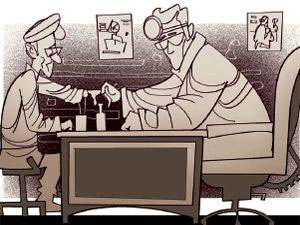By Dr. Arun Jithendra and Dr. Zeena Johar 1
India is a country of 1.2 billion people. One estimate, provided by the World Health Organisation, suggests that on average one physician is required to serve 1,000 people, across all levels of care. This implies that we need a total of 1.2 million physicians to serve our population. However, the total number of formally qualified allopathic doctors in the country is estimated to be only about half that number with fewer than 30,000 being added every year, despite the fact that we have one of the largest numbers of medical colleges in the world. It is clear from these numbers that there is a large gap in the availability of allopathic doctors that is likely to persist. It is also now known that physicians who have formal degrees Ayurvedic, Siddha, and Unani, disciplines are legally permitted to offer allopathic services to their patients. And, there are over 750,000 registered AYUSH (Ayurveda, Yoga, Unani, Siddha, and Homeopathy) practitioners in the country, about 70% of who fall under the legally permitted categories. These numbers when combined with the total number of physicians who are trained in the allopathic tradition start to come close to the total requirements of medical practitioners that we need as a country. While examining these ideas it is also important to note that India is not alone to explore this direction. A number of other countries around the world have very successfully relied on personnel drawn from allied disciplines to make up for shortages of formally trained medical practitioners addressing their unwillingness to serve in remote locations or in primary care settings. In the Unites States of America for example, Nurses have been asked to step-up to the plate and fill-in the enormous gaps in the availability of medical personnel both in urban as well as rural settings.

Having established that such personnel are indeed available and taking comfort from the fact that we are not alone in exploring the use of alternate and allied human resources, the next and perhaps the most important questions concerns the competency of these alternate providers to actually offer allopathic medical care. In the United States it is possible to get a Registered Nursing degree, with a focus on bed-side and Emergency Room nursing, after just a year-long training programme for a person that has taken biology and other life sciences in college. To qualify to be a Nurse Practitioner and practice allopathic medicine independently, an additional 11 months of training is required. In India the Ayurvedic, Unani, and Siddha practitioners receive a much longer 5.5 years of intensive medical training. A careful comparison of the academic training undergone by them with that offered to MBBS doctors reveals that their curriculum is designed in a very similar manner. The first three years of training in all the four disciplines is primarily structured around principles of biochemistry, anatomy, physiology, pharmacology, pathology, microbiology, along with subjects that focus on traditional medicinal learning such as medicinal botany and metal, minerals and animal kingdom. The last 18 months of training focus on hygiene and community medicine, forensic medicines and toxicology, general medicine, special medicine, surgery, obstetrics and paediatric medicine. There is however a significant gap in pharmacological training, relating to the pharmacodynamics and pharmacokinetics of modern drugs, which needs to be bridged. In addition, training in areas such as mental health, geriatrics, ophthalmology, dentistry, maternal care, cervical screening and treatment, dental procedures, and emergency patient management would also need to be added.
In our work on the ground with a local healthcare provider in Thanjavur we have extensively worked with Ayurvedic, Siddha, and Unani physicians at health centres which are operating in remote rural locations. We have designed an intensive six month long curriculum to bridge the gaps between their training and what is needed for the practice of allopathic care in primary care settings. However, we have realised that, in order to be effective, the training needs to be supplemented with strong protocols and audit and control mechanisms. For this purpose we have therefore developed very detailed diagnosis and treatment protocols that go well beyond Standard Treatment Guidelines in the detail to which actual treatment regimens and dosages are described. These protocols not only act as good training materials but also provide a strong framework within which all physicians are required to operate, and are audited against, to ensure a high level of consistency and quality in the care that is offered in each of these clinics. To ensure a high degree of control, the physicians are also required to enter every patient’s information on a real-time basis into a Health Management Information System (HMIS) developed by us. Currently physicians are required to select the appropriate treatment protocol to follow using their bridge training and their judgement – the audit merely seeks to confirm the appropriateness of this judgement after-the-fact. Gradually we are building more “intelligence” into the HMIS so that it can guide the physicians’ choice of diagnostic procedures and treatment protocols.
In our experience this combination of bridge-training, detailed protocols, and strong control using technology, has worked beautifully on the ground and has the potential to scale on a nation-wide basis. We are now working to structure this bridge-training programme into a formal certificate course which can be used widely in many different settings.
This article first appeared in The Economic Times on Thursday (August 09, 2012).
1 Dr. Arun Jithendra and Dr. Zeena Johar are with the IKP Centre for Technologies in Public Health.


Leave a Reply
Be the First to Comment!